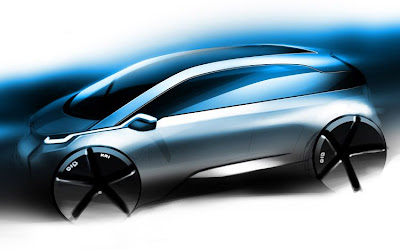2013 BMW Megacity Electric Car

The BMW Megacity vehicle (MCV) will be the first vehicle BMW releases under the moniker of an as-yet-unannounced, all-new sub-brand. It represents some radical thinking on BMW's part and includes a subframe of carbon-fiber (produced at a plant in central Washington state), covered in panel of extruded aluminum.
The MCV's battery is mounted low and in the middle of the car, whereas the motor and single speed transmission are mounted at the rear and drive rear wheels.
According to Autocar's unnamed source, BMW also says a range extended version of the MCV with a 1-liter, 2-cylinder engine is possible. BMW's "huge" research and development program for the MCV began in 2007. “Strategy number one,” an unnamed BMW source told Autocar, “was an attempt to create the future, understanding future customer needs and accessing key new technology. BMW envisions three types of customers in the future: responsibility-driven buyers who are most concerned with environmental issues, economy-driven customers worried about overall ownership costs, and lifestyle-driven customers who have disposable income but demand environmental friendly products.
BMW has made good on their plans for developing an urban vehicle for the metropolitan areas. According to BMW, it will be the world’s first volume-produced vehicle with a passenger cell made from carbon. The Megacity Vehicle will be built on a new LifeDrive architecture that will help reduce the car’s weight by 250 to 300 kilos.
The LifeDrive concept consists of two horizontally separated, independent modules. The Drive module integrates the battery, drive system, and structural and crash functions into a single construction within the chassis. "The drive system remains the heartbeat of a car, and that also applies to electric vehicles. --: Apparently, BMW has big plans for their Megacity Vehicle, or the i3. In an interview with Automotive News, Ian Robertson, BMW’s global sales and marketing boss said that the company plans to sell 30,000 units a year: "sales volume for the i3 could be comparable to one of the lower-volume Mini derivatives.
Distributed to hand-picked customers for a one-year lease term, the all-electric Mini has a sub-100-mile range and sacrifices the rear seats and most of the cargo compartment to house its batteries. In 2013, the car, which is currently called Megacity vehicle (MCV), will be launched under "one of BMW's brands." The electric powertrain allows for a unique vehicle architecture. BMW separates the car into two parts, the lower "drive module" and the upper "life module." Together with SGL Carbon, BMW has developed a carbon-fiber passenger cell, with additional aluminum crash structures front and rear. The MCV will be the world's first mass-produced car with a carbon-fiber passenger cell. It all stays within the family: BMW's largest shareholder, the Quandt family, is heavily invested in SGL Carbon.
The weight savings are crucial to compensate for the heft of the electric powertrain and batteries—some 500 to 800 pounds for the batteries alone. To improve range, BMW is pondering the use of a range-extender engine with 30 to 45 hp, but it is seen as a crutch and a temporary solution until battery technology sufficiently improves. The MCV's electric motor will produce well north of 135 hp, says BMW. No word yet on performance, but BMW engineers insist it will give us joy, in accordance with the company’s new advertising tagline.
